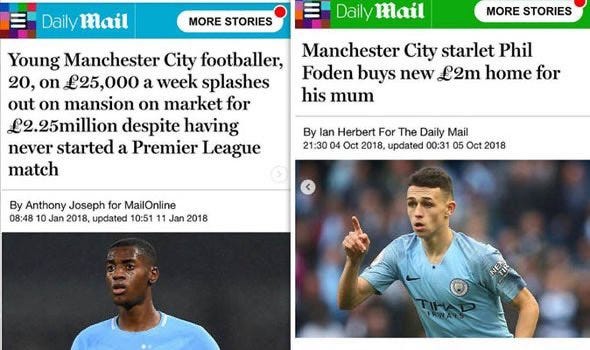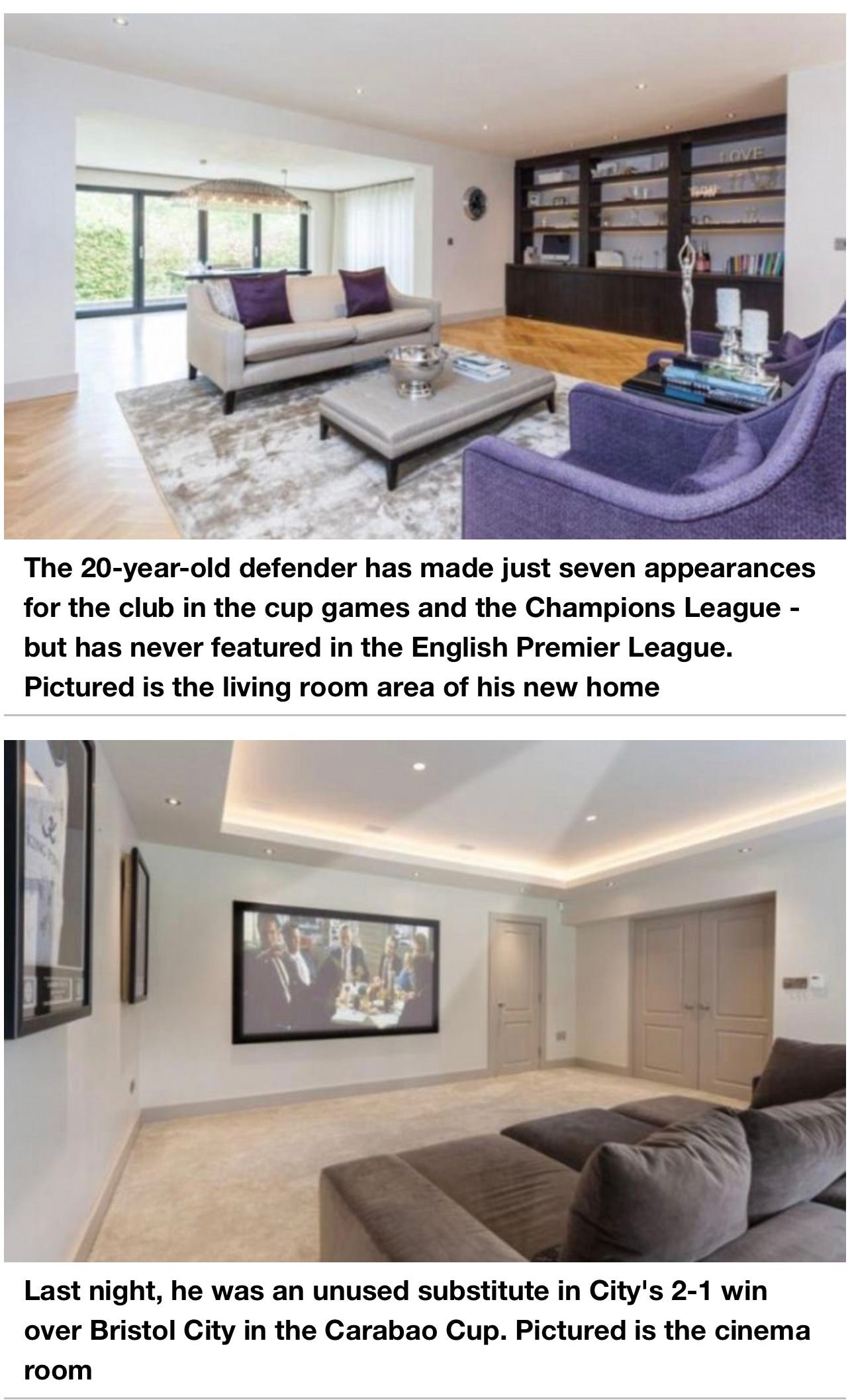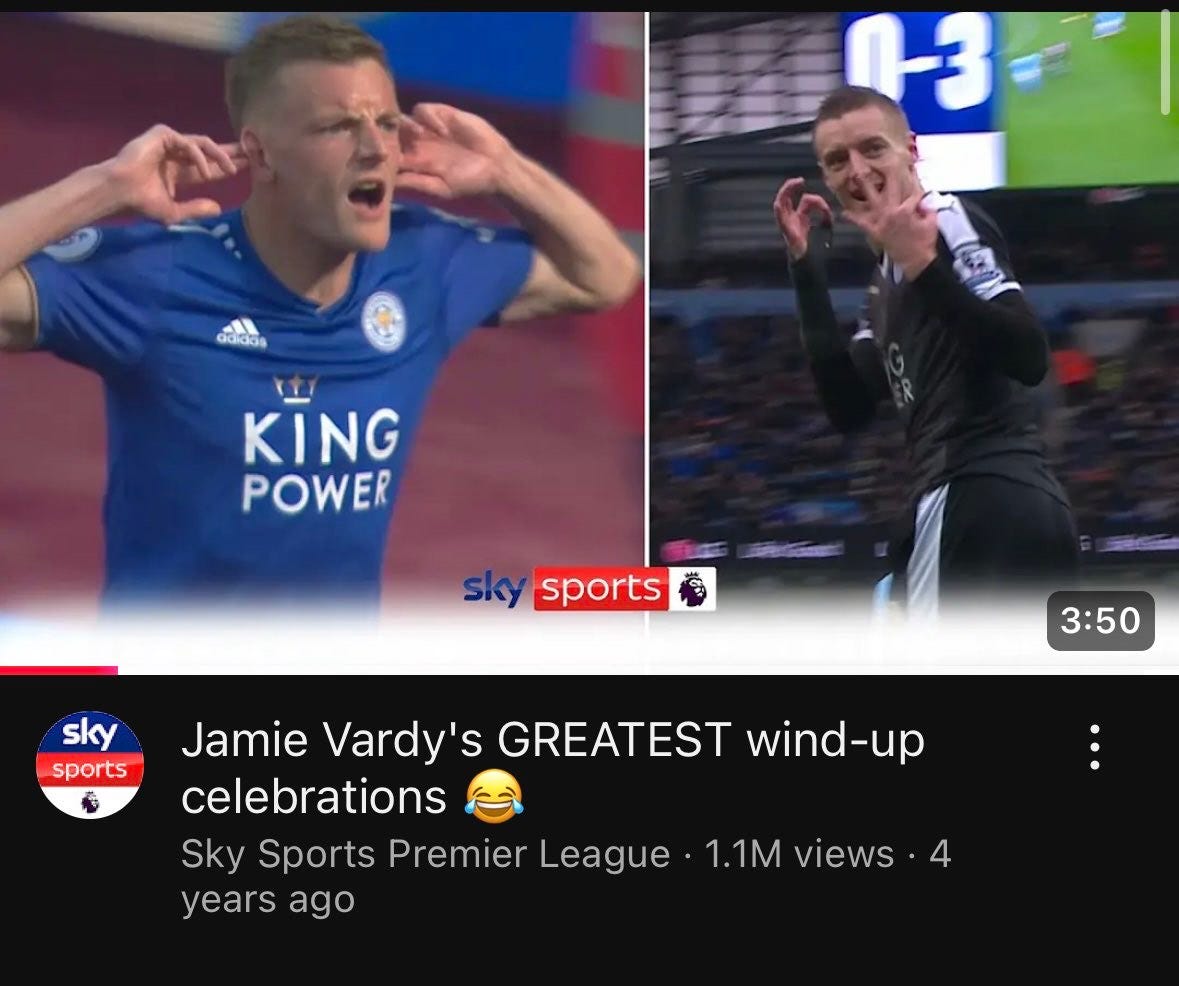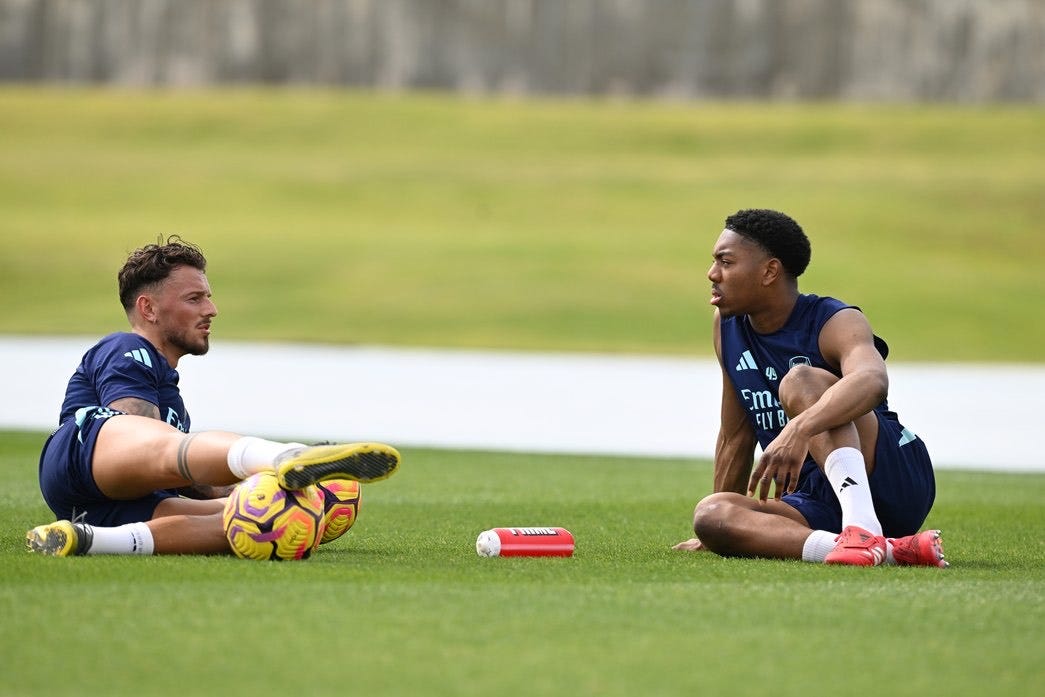Why No. 49 is Once Again Public Enemy Number One
On how English football is rearing its ugly underbelly in the aftermath of Myles Lewis-Skelly's celebration against Manchester City.
By now, we’ve all seen that clip of Sol Campbell on AFTV floating around. You know the one. “Is it a color thing?” the Invincible asks. “Is it a color thing? Is there an underbelly color thing that keeps you going?”
At the time, Campbell was talking about possible reasons for why Spurs fans still directed so much ire toward him, a quarter of a century after moving across north London to Arsenal, when many other players had completed similar moves and weren’t really spoken about the same way. But as these things sometimes do, the moment of Campbell questioning this phenomenon took on a life of its own on social media. When the clip containing this quote initially surfaced, it was an instant hit as a meme. Every propping up of Phil Foden at the expense of Bukayo Saka was met with an .mp4 file of Campbell asking, “Is it a color thing?” Every inconsistent take regarding player behavior saw a quote tweet displaying a screenshot of the former Arsenal man’s face with a suspicious look on it. Collectively, Arsenal Twitter used the moment for some lighthearted humor. But of course, we all knew there was more than a kernel of truth to what Campbell said.
Just a matter of days later, the clip doesn’t feel as funny anymore. It’s easier to mock problematic behavior when the people engaging in it are falling over themselves to keep the evidence from seeing the light of day. But when it’s being brazenly brandished, without shame, without remorse, most attempts to mortify perpetrators through laughter fall flat. Oftentimes, righteous anger is required instead.
I’m speaking, of course, about the treatment of Myles Lewis-Skelly that we’ve witnessed in recent weeks. You could say it started when the 18-year-old was wrongly sent off by Michael Oliver at Wolves. And we’ll get to that. But if you ask me, this all began in September.
It perhaps should have been a sign of things to come when Lewis-Skelly saw a yellow card before he had even stepped on the pitch to make his league debut at Manchester City. Michael Oliver (funny how he keeps popping up) heard the young Englishman advise David Raya to go down and waste time entering the final third of the match, and cautioned him while he was still on the touchline in his warmup bib — something I’m not sure I’ve ever seen in football. Lewis-Skelly would eventually come on to replace the injured Jurrien Timber. And after being unable to prevent City from equalizing at the death, he was dragged back into the spotlight when Erling Haaland decided to scream obscenities in the face of a teenager.
A few months later, Oliver took it upon himself again to punish the young Arsenal player. At Wolves in January, Lewis-Skelly tripped Matt Doherty as he attempted to spring a counterattack out of Wolves’ penalty are following an Arsenal corner. It was a cynical but routine foul that likes of Rodri have built a career off of. But when Arsenal’s no. 49 did it, the referee saw fit to send him off immediately. VAR inexplicably confirmed the decision, and Lewis-Skelly trudged off the pitch, reportedly distraught.
The footballing world overwhelmingly questioned the dismissal. As the FA, PGMOL, and their allies in the media all closed ranks in defense of Oliver, Lewis-Skelly was left with a target on his back for abuse. But it’s not the online component of the vitriol that stands out to me here. Sure, there were the usual cowards hiding behind anonymity on Twitter while calling a teenager “arrogant” or a “thug”, and those people are losers who need to take a good, long look at themselves in the mirror. But what particularly stuck in my craw is how certain journalists responded.
In particular, it will be a long time before I forget Andy Dunn’s article on the matter. The Mirror’s chief sports writer penned an piecewith a headline calling Lewis-Skelly “the real villain” even after an independent panel had overturned the red card. That title has since been changed, no doubt due to the backlash that Dunn faced, but the piece still insists that the 18-year-old “was no victim” and “premeditated an act of foul play”. This is, of course, after the article’s preceding paragraphs decry the criticism of Michael Oliver and question the impartiality of the panel that overturned the sending off.
Now, there’s a certain word I could use to describe this sort of language. But I don’t want to claim to know Dunn’s thought process in writing this article, so I’ll hold off on ascribing that label to him. What I will say is this: England, like the United States, is a nation that has certain feelings toward diversity and minorities in certain parts of the country. People grow up surrounded by messaging that consciously and subconsciously influences their beliefs on these matters. So perhaps Dunn doesn’t know that his piece sounds like a Fox News segment after a “police-involved shooting” of an unarmed person of color.
Regardless, Arsenal scraped three points at the Molineux and welcomed City to the Emirates with Lewis-Skelly cleared to participate. And the Gunners got their revenge for the September result, thumping Pep Guardiola’s men 5-1. Among the goalscorers was Lewis-Skelly, who dribbled into City’s penalty area and curled in Arsenal’s third goal. And to celebrate this monumental moment in his career, scoring against the four-peat Premier League champions in his debut season, he decided to cheekily imitate a celebration that Haaland was known for.
For people who genuinely enjoy football being a fun sport, it was a great moment of personality in what has become the league’s most entertaining rivalry in years. Two teams with no love lost for one another, trading blows, getting in each other’s faces, and thumbing noses at the opposition every chance they get? That’s gold-standard viewing. That is the stuff of money-making ratings, is it not?
Unfortunately, the conversation centered around Lewis-Skelly’s celebrations, reaching a level of pearl-clutching that was impressive even for today’s troll-dominated football media landscape. Suddenly, it was against the rules for an 18-year-old to give a little back to a player if they hadn’t won a trophy in their career yet, or if they hadn’t scored as many goals. The days following a statement win for Arsenal saw men huddled around microphones in rented studios bemoaning a lack of respect for fellow professionals. The Premier League itself came out and said it would monitor celebrations in matches and hand out punishments if they deemed such expressions to amount to mockery or criticism.
Then there were the less subtle attacks. Online, several miscreants could be found wishing broken ankles and other career-threatening injuries on Lewis-Skelly — who, I feel I must remind you again, is eighteen years old. But perhaps the cream of the crop here is one Jason Cundy, who really shouldn’t be saying the things he does with a last name like that. Cundy, who previously stated in 2022 that Ethan Nwaneri being handed a Premier League debut at 15 was nothing more than a “self-indulgent” move by Arteta, and not an honor bestowed upon an amazing young talent who had earned the privilege, had some choice words for Lewis-Skelly on talkSPORT. The former Spurs man, like with the air of a cheap Disney villain, said of Lewis-Skelly’s celebration:
“I’m not convinced it’s the wisest thing to do… There’s plenty years to come. You wait… We saw what Roy Keane did to Haaland’s dad. You know… I’d just be careful if that was you.”
A 55-year-old with a wife and three kids said that about a teenager. While his mate, another former Spurs man in Jamie O’Hara, sat there and smirked. And something about it felt a little sinister, almost as if Cundy was willing the universe to make his words reality. Because Lewis-Skelly had dared to show some personality, dared to stick up for himself, suddenly he deserved to have a broken leg.
And sure, part of this might just be people saying despicable things in the media for a little attention. It’s not much of a secret that you can get plenty of clicks and make some money off riling up the Arsenal fanbase. For some pundits, that’s probably the full extent of it.
But this also goes deeper than a bad faith bid for attention. The furor directed toward Lewis-Skelly is just the latest episode within decades of discrepancies between how footballers are treated in England. Discrepancies that correlate quite closely with the color of said footballers’ skin. Let’s call this what it is: racism.
And here might be where I lose some people. So I want to stress something: racism isn’t just saying certain forbidden words. It isn’t just loudly and brashly declaring, “I don’t like you because you look different than I do.” It can take the form of unconscious bias that results in subtle but noticeable differences in how people are treated. In my humble opinion, most people don’t just wake up one day and decide to do something racist. It’s the result of systematic and subliminal influence. And it’s something that many in the English media have yet to unlearn or denounce.
The photo above shows different articles, released by the same publication, in the same year, about players from the same club. On the left, Tosin Adarabioyo is chastised for purchasing a house valued at just over £2 million. Look at the language used — the headline goes out of its way to point out how young Adarabioyo was at the time, reveal his weekly salary, characterize the house as a “mansion”, give a more exact value of the property, and inform the reader that he had never started a Premier League when he made the purchase. The headline does this! Without so much as naming the player it’s attacking. And then the body of the piece itself features jabs like these:
The clear intent of the article is to paint Adarabioyo as an irresponsible and frivolous spender, who childishly spent his first big paycheck on a massive house that he doesn’t deserve. Additionally, the article overtly insinuates that the defender doesn’t deserve the house he’s purchased due to his lack of game time at City. With this piece, the Daily Mail ensured readers came away thinking less of Adarbioyo.
On the right is a piece about Phil Foden essentially doing the same thing. But it is received much differently by the same publication. Foden is referred to as a “starlet” despite only playing a little over 300 minutes of senior football the season before. The headline doesn’t get into specifics regarding the price of the house Foden bought, but made sure to clarify that the property was purchased for his mother — not as some self-interested splurge, but as a “home”.
Adarabioyo’s teammate at the time, and Lewis-Skelly’s teammate currently, Raheem Sterling, spoke out against this disparate treatment. In a social media post he wrote following racial abuse he himself suffered, he stated:
"You have two young players starting out their careers — both play for the same team, both have done the right thing, which is buy a new house for their mothers who have put in a lot of time and love into helping them get where they are.
But look at how the newspapers get their message across for the young black player and then for the young white player.
I think this is unacceptable, both innocent, have not done a thing wrong but just by the way it has been worded, this young black kid is looked at in a bad light, which helps fuel racism and aggressive behaviour."
Sterling himself has had to endure plenty of racial attacks from English media. The same year The Daily Mail published those pieces about Adarabioyo and Foden, The Sun put out an article titled “Love rat Raheem Sterling proposes to long-suffering girlfriend Paige Milian”. Instead of celebrating a footballer’s imminent marriage, the paper decided to unnecessarily mention Sterling’s prior use of nitrous oxide, a child from a past relationship, and his friendship with a model, probably to suggest that he is a dishonest and untrustworthy fiancé. The Sun referred to Sterling as a rat the previous year as well, in a piece titled “Prem Rat of the Caribbean”. Clearly The Sun purposefully aimed to portray the English winger as unworthy of his success, as unworthy of love and adoration despite being one of the world’s best players in his position.
In the meantime, Jack Grealish is celebrated for public drunkenness and being unable to read a map of England. Wayne Rooney’s career is admired for his aggression toward opposing defenders and referees almost as much as it is for his sensational moments of footballing ability. Joey Barton has earned a truckload of assault charges, stubbed out a cigarette in a youth player’s eye, and is currently awaiting retrial regarding domestic abuse he allegedly committed, but he was allowed to enjoy extensive careers as both a player and a pundit.
But when Marcus Rashford tried to become more than a footballer and use his influence to combat food poverty in the United Kingdom, the English media systematically targeted him in an attempt to depict him as a wayward party boy. When Paul Pogba presented as an unashamedly bold and unorthodox addition to the Premier League, Graeme Souness obsessed over criticizing him during his time at Manchester United to the point that it became a meme, calling him “lazy”, questioning whether he had a “football brain”, and branding him as a “selfish player” over the course of countless attacks. And when Sterling got a tattoo of an assault rifle on his leg — honoring his father, whom he lost to gun violence in Jamaica, with a statement that he would only shoot with his right foot and never with a gun — his detractors in the media rushed to assume he was aiming to glorify firearms.
This consistent disparate treatment of Black footballers has an impact on how they’re treated by football fans. Seeing Sterling called a rat, Rashford criticized every time he’s seen clubbing, and Pogba’s commitment questioned every time he dyes his hair is harmful subliminal messaging. It tells consumers of English media that there are different, more stringent standards of conduct Black players have to conform to while continuing to play well. And if they don’t, those fans have every right to say horrific things to and about them. Like when Rashford, Jadon Sancho, and Bukayo Saka were forced to endure an onslaught of monkey emojis in their comments sections on social media after they missed penalties in the Euro 2020 final. Or when Bunny Shaw faced so much racist and sexist abuse in the past week that she needed to take time off from football for her own mental health.
So it’s no wonder that when Jamie Vardy scores against Spurs and tells them he’s won more titles than they have, it’s a great bit of banter. Or that when Neal Maupay mimics players’ celebrations or purposefully antagonizes them, he’s being the right kind of cheeky. Or that Erling Haaland pegging a ball at the back of Gabriel’s head, screaming obscenities at full volume in a teenager’s face, telling a manager to stay humble, and commanding a former teammate to “shut up, you fucking clown” in the span of a few minutes is just him being an admirable competitor. It’s all a part of football. It’s one of the things that make the sport fun, to the point where broadcasters post compilations of these actions on their YouTube channels for a little extra revenue.
But when Myles Lewis-Skelly imitates the man who bellowed, “Who the fuck are you?” at him after scoring an impressive first senior goal against the reigning league champions, it’s not fun anymore. Pundits gather on their networks with concerned faces to discuss a goal celebration like it’s a matter of national security. Jamie Carragher effectively tells Lewis-Skelly to remember his place and even reprimands Declan Rice for not reminding the 18-year-old of it. The powers that be in football deem it necessary to intervene and change the rules so they can punish the next person to commit this grave offense.
And if you see all this and still think it’s more appropriate to ask, “Is it an Arsenal thing?”, then perhaps it’s pertinent to bring up the club’s history over the last several decades. Even before Arsene Wenger arrived from Nagoya Grampus Eight, players like David Rocastle and Ian Wright laid the groundwork for Arsenal to become synonymous with Black culture and identity in London. But Le Professeur ratcheted up the Gunners’ embrace of Black and African players, signing footballers such as Patrick Vieira, Thierry Henry, Nwankwo Kanu, Kolo Toure, Sol Campbell, and Lauren. In 2002, Wenger’s Arsenal became the first club to name nine Black players in a Premier League starting XI.
Under Wenger, Arsenal became othered, regarded as a “foreign club”. His revolutionary approach to player nutrition and conditioning, nonconformity with the custom of post-match drinks with other managers, and assembly of an increasingly diverse squad ruffled the feathers of traditionalists. Naturally, some of those traditionalists held platforms in the English tabloids and media. Whenever Arsenal struggled under Wenger, his critics would snidely instruct him to avoid signing less “established” players and target those more suited to British culture.
Much to their detractors’ chagrin, this diverse Arsenal team went on to put together the immortalized Invincibles campaign during the 2003/04 season. They reached 49 matches undefeated, surpassing Nottingham Forest’s previous record of 42 games without a loss. It could have been a half-century of matches undefeated for Arsenal, but Mike Riley saw fit to allow fellow Northerners from Manchester United to hack the Gunners down when they were in on goal, commit studs-up challenges and go unpunished, and award a penalty for a clear Wayne Rooney dive.
Obviously, it’s hard to prove these things because it requires evidence of what’s in the hearts of others. But in a league in which certain attitudes had long prevailed, which treated the emergence of an Arsenal that looked and thought and played differently as an unwanted development, no. 49 was not allowed to become no. 50. And over the years since that Invincibles title, in the face of unrepeated refereeing anomalies and horrific injuries to players caused by unimpeded violent conduct, it has occasionally felt like Arsenal are being punished for daring to challenge the status quo as they did almost three decades ago.
It’s an interesting little cosmic thread to see now — a young man, rising through the ranks from Hale End to Arsenal’s senior squad, wearing a number on his back that bears so much significance in the club’s history, facing England’s bigoted underbelly because he showed the kind of personality some football fans claim to love while not having the skin color they favor. For the crime of not “keeping his head down”, Lewis-Skelly now has a target on his back at the very outset of his career. Every tackle, every night out, every girlfriend, every moment of joy and confidence in his life will be scrutinized.
Thankfully, Lewis-Skelly seems to have an amazing support network around him by all accounts, including a remarkable woman in his mother Marcia. He has a manager and teammates willing to go to bat for him publicly. He has Raheem Sterling, Bukayo Saka, and Ben White (another Arsenal player who has drawn the ire of English media) in training with him every day to offer their experience and guidance. Myles Lewis-Skelly will be fine. I’d even go so far as to say that I think he’ll help Arsenal win things in the near future.
It’s just a shame the deck keeps getting stacked and against him and so many others who deserve far better. And it most certainly is a color thing.
If you enjoyed this post, please consider following me on Twitter @Shamsdale or on Bluesky @shamsdale.bsky.social.






